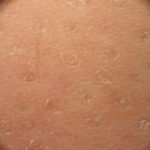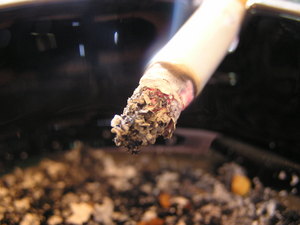At the risk of much, much negative e-mail from eczema and acne sufferers, I am going to go ahead and dub Keratosis Pilaris as the utmost worst superficial skin condition to be stuck with. Why, you ask? Well, not only does it consist of hundreds of unsightly tiny red bumps covering your upper arms and thighs, but it is inexplicably ignored by the beauty and dermatologic industries. While eczema and acne sufferers have tons of treatments and products bombarding them from skin care powerhouses like Neutrogena and Murad, Keratosis Pilaris sufferers have very few options, save for a much negatively reviewed line by DERMAdoctor, available at Sephora.
Keratosis Pilaris web sites and message boards contain a lot of unfortunately desperate people with a lot of silly, far-fetched remedies. One message board contains a much-responded to thread promoting “oil pulling” as a possible cure. Oil pulling is the process of swishing 2-3 tablespoons of oil (sesame and sunflower are recommended) first thing in the morning for a ludicrous fifteen to twenty minutes. Supposedly, the oil will turn from filmy and yellowy to white and foamy, as it has allegedly absorbed all the negative toxins from your system. This new age home remedy is so out there (not to mention of unverifiable effectiveness) that you’d have to be truly miserable with your skin to even try it. Gargling oil for twenty minutes first thing in the morning for nice skin? Before I’ve even had coffee? Give me a break. Another thread on the same message board suggests trying peanut butter as a cure. Not as in, eat more peanut butter for health benefits, but rather use it as a mask on the affected areas of your skin.
To treat your Keratosis Pilaris effectively, you have to first understand what it is. Keratosis Pilaris occurs when keratin, a naturally occurring protein in the skin, builds up in the hair follicles and produces hard plugs. Basically, it’s sort of like how acne is formed when oil and grime clog pores. Keratosis Pilaris is really common, affecting an estimated 40-50% of the population, and occurring more frequently in women. It is a chronic condition that one may or may not “age out of”; many doctors tell young patients that it will disappear in their twenties, but I am living proof that is not always the case.
Notice above I said how “to treat” your Keratosis Pilaris, not cure it. There is much you can do to lessen the appearance and smooth the bumps, but most people who have Keratosis Pilaris are stuck with it for life. Although it definitely sucks, remember it could be worse, and approach treating it logically. Exfoliation is essential. There are three ways to do this: manually, chemically, or both. Manually involves physically scrubbing the affected areas with a scrub. There are tons of granular scrubs on the market, but most are heavily scented and ineffective for the treatment of this condition. The best bet is to use microdermabrasion crystals, which are widely available online, combined with a light soap free cleanser such as Cetaphil to create an unscented tough-as-nails scrub. The best way to use this treatment is before you shower on dry skin. Also, don’t just lightly rub the mixture in soft circular motions; really go at it. Spent a good chunk of time really exfoliating with the dermabrasion crystals, use a fair amount of pressure, but of course not as much as to cause pain or discomfort.
The second option is to exfoliate chemically. This entails using a lotion with a high Alpha-Hydroxy or Glycolic acid concentrate. While there are many acid based moisturizers on the market, most have low acid concentrate designed to smooth – forgive me for this – normal skin. You will need a lotion with a 15-20% acid concentrate, which currently are only available online. You will also need to be very careful with these products, as they are quite strong and could irritate sensitive parts of your skin. This Keratosis Pilaris help-site has great links to Alpha-Hydroxy acid lotions, plus much more information about manual exfoliation, and I highly recommend it.
The bottom line is that treatment for Keratosis Pilaris takes time. Use logical exfoliation techniques, and be consistent and patient. And remember – while having Keratosis Pilaris may seem like a fate worse than death, keep in mind that people probably don’t notice nearly as much as you think they do.




